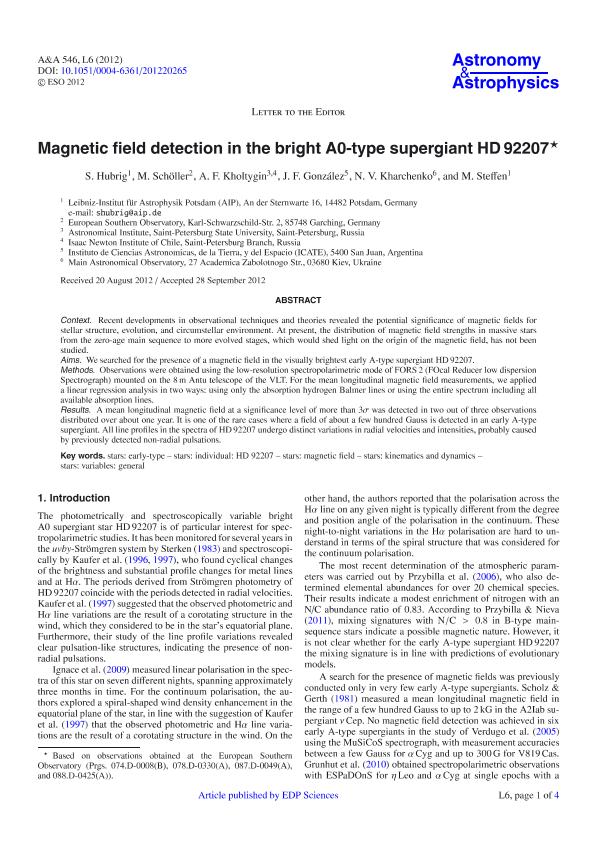Mostrar el registro sencillo del ítem
dc.contributor.author
Hubrig, S.
dc.contributor.author
Schöller, M.
dc.contributor.author
Kholtygin, A. F.
dc.contributor.author
Gonzalez, Jorge Federico

dc.contributor.author
Kharchenko, N. V.
dc.contributor.author
Steffen, M.
dc.date.available
2019-01-31T18:29:03Z
dc.date.issued
2012-10
dc.identifier.citation
Hubrig, S.; Schöller, M.; Kholtygin, A. F.; Gonzalez, Jorge Federico; Kharchenko, N. V.; et al.; Magnetic field detection in the bright A0-type supergiant HD 92207; EDP Sciences; Astronomy and Astrophysics; 546; 10-2012; 1-4; L6
dc.identifier.issn
0004-6361
dc.identifier.uri
http://hdl.handle.net/11336/69126
dc.description.abstract
Context. Recent developments in observational techniques and theories revealed the potential significance of magnetic fields for stellar structure, evolution, and circumstellar environment. At present, the distribution of magnetic field strengths in massive stars from the zero-age main sequence to more evolved stages, which would shed light on the origin of the magnetic field, has not been studied. Aims. We searched for the presence of a magnetic field in the visually brightest early A-type supergiant HD 92207. Methods. Observations were obtained using the low-resolution spectropolarimetric mode of FORS 2 (FOcal Reducer low dispersion Spectrograph) mounted on the 8 m Antu telescope of the VLT. For the mean longitudinal magnetic field measurements, we applied a linear regression analysis in two ways: using only the absorption hydrogen Balmer lines or using the entire spectrum including all available absorption lines. Results. A mean longitudinal magnetic field at a significance level of more than 3σ was detected in two out of three observations distributed over about one year. It is one of the rare cases where a field of about a few hundred Gauss is detected in an early A-type supergiant. All line profiles in the spectra of HD 92207 undergo distinct variations in radial velocities and intensities, probably caused by previously detected non-radial pulsations.
dc.format
application/pdf
dc.language.iso
eng
dc.publisher
EDP Sciences

dc.rights
info:eu-repo/semantics/openAccess
dc.rights.uri
https://creativecommons.org/licenses/by-nc-sa/2.5/ar/
dc.subject
Early-Type
dc.subject
Individual: Hd 92207
dc.subject
Kinematics And Dynamics
dc.subject
Magnetic Field
dc.subject
Variables: General
dc.subject.classification
Astronomía

dc.subject.classification
Ciencias Físicas

dc.subject.classification
CIENCIAS NATURALES Y EXACTAS

dc.title
Magnetic field detection in the bright A0-type supergiant HD 92207
dc.type
info:eu-repo/semantics/article
dc.type
info:ar-repo/semantics/artículo
dc.type
info:eu-repo/semantics/publishedVersion
dc.date.updated
2019-01-31T14:02:43Z
dc.journal.volume
546
dc.journal.pagination
1-4; L6
dc.journal.pais
Francia

dc.journal.ciudad
Paris
dc.description.fil
Fil: Hubrig, S.. Leibniz Institut für Astrophysik Potsdam ; Alemania
dc.description.fil
Fil: Schöller, M.. European Southern Observatory; Alemania
dc.description.fil
Fil: Kholtygin, A. F.. Saint Petersburg State University; Rusia. Isaac Newton Institute of Chile. Saint Petersburg Branch; Rusia
dc.description.fil
Fil: Gonzalez, Jorge Federico. Consejo Nacional de Investigaciones Científicas y Técnicas. Centro Científico Tecnológico Conicet - San Juan. Instituto de Ciencias Astronómicas, de la Tierra y del Espacio. Universidad Nacional de San Juan. Instituto de Ciencias Astronómicas, de la Tierra y del Espacio; Argentina
dc.description.fil
Fil: Kharchenko, N. V.. Main Astronomical Observatory; Ucrania
dc.description.fil
Fil: Steffen, M.. Leibniz Institut für Astrophysik Potsdam ; Alemania
dc.journal.title
Astronomy and Astrophysics

dc.relation.alternativeid
info:eu-repo/semantics/altIdentifier/url/https://www.aanda.org/articles/aa/abs/2012/10/aa20265-12/aa20265-12.html
dc.relation.alternativeid
info:eu-repo/semantics/altIdentifier/doi/http://dx.doi.org/10.1051/0004-6361/201220265
Archivos asociados
